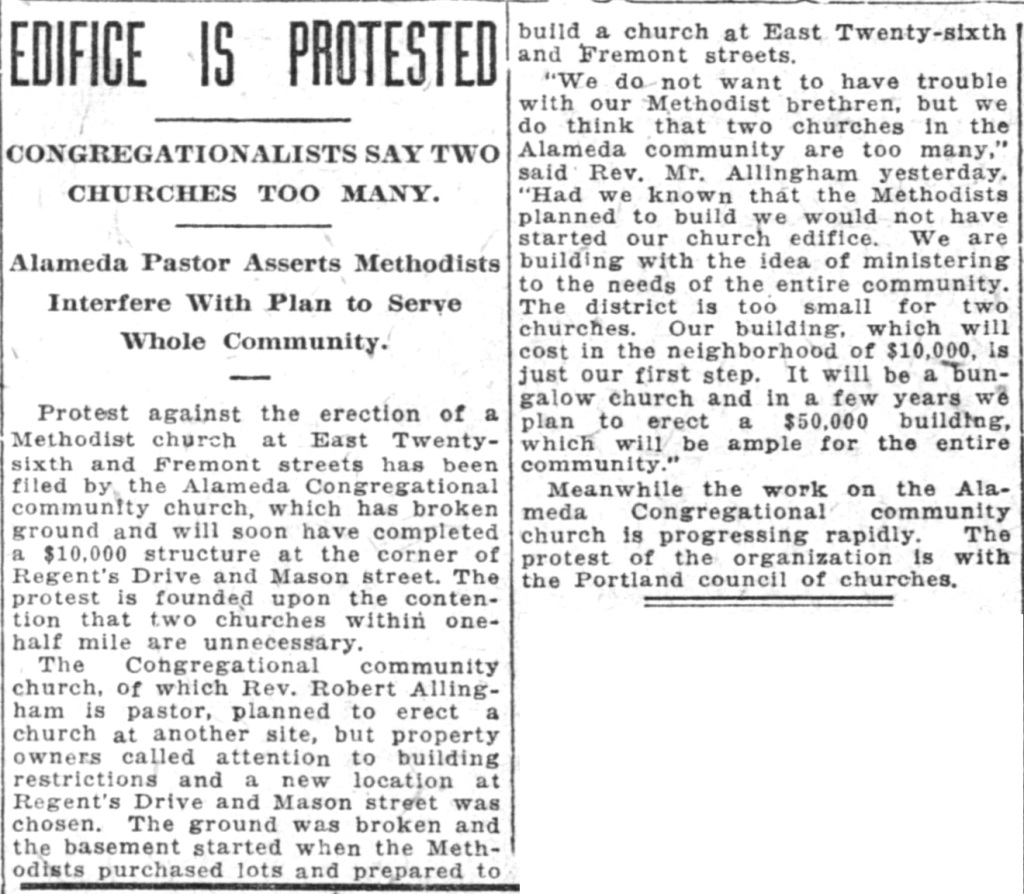Alameda Park Community Church: Today’s Subud Center
Funny how decisions are made sometimes, and how unpredictable forces shape the way things turn out.
For 80 years, Alamedans have known the Alameda Park Community Church building– today’s Subud Center — as a friendly-looking building on an island just off Regents Drive at Mason.
Passersby inclined to wonder about its history perhaps think it was a big house originally, or a community center. Potluck dinners, friendly gatherings, sing-alongs, dances, lectures, church services, meditation sessions: Yes, this building has seen it all. But it very nearly didn’t get built. Check out this story from The Oregonian on October 4, 1921:

And this was the second hurtle the project had to overcome, after being relocated, before work really got underway, from its original and intended location one block west near the corner of NE 30th and Mason. According to the building records, and a handed-down memory from Bruce Morrison, the “little boy” who grew up in my house (who was 90 when I interviewed him), it didn’t take long for his dad Walter Morrison to make a fuss when the builder began site preparation on the lots next to ours.
Yes, there was a significant amount of construction going on in “The Park,” as in Alameda Park, the early name of our neighborhood. But when Walter found out the building adjacent to his house was going to be a church, he took his protest directly to the Bureau of Buildings downtown, and to the Alameda Land Company, which had promised to build nothing but homes in the area until 1929.
Like many other early homeowners in the area, the Morrisons purchased here because it was solely residential: No commercial or other buildings were permitted within the confines of Alameda Park. The Morrisons were church-going people…it seems that Edith and Walter just weren’t wild about the constant flow of traffic in front of their house.
So, in response to Walter’s initial complaint, the city worked with the church and all agreed to move the location to the island off Regents Drive one block east, “Block C” as it is known in the property records.

Detail from Sanborn Map Volume 5, Plate 586, 1924.
Logistically, this wasn’t too big a problem because not much work had been done on the initial site. The crew picked up its tools and moved one block east. Layout, site preparation and excavation followed, and then the foundation went in. And that’s when the 35 property owners raised a ruckus and shut down the construction. Here’s the next story, from The Oregonian on January 14, 1922:

Sounds messy, doesn’t it? The developer got involved, and other property owners. I can imagine some tense meetings and feelings between neighbors. Not nice. It was, however, pretty neat to find this clipping, which confirms the handed-down memory from Bruce Morrison’s mom Edith. So what happened next? Read on, from The Oregonian on January 29, 1922:

So the judge dismissed the suit, some reasonable and community-minded behind-the-scenes agreements were probably made, and the construction was cleared to move forward at full speed. Which it did. Here’s a report from The Oregonian on October 3, 1922 as the building was readied for opening. It’s interesting the article is still referring to 30th and Mason, even though the building has clearly been moved one block east:

Built at a total cost of $5,000, the church was actually a kit, constructed by the Redimade Building Company, and plumbed by Alaska Plumbing and Heating for the Congregational Church Building Society, headquartered in New York City. An additional wing of the building was added in 1924 by the Traverse-Bennett Construction Company.
Check out these drawings of the original church.
After dedication, The Rev. H.C. Johnson took over the permanent post from The Rev. Robert Allingham, and all kinds of good works, events and gatherings began to take place on “Block C.” Read more from The Rev. Allingham about what the experience of opening the church was like.
In a deeply ironic post-script to history, I am compelled to share the rest of this story from the turn-the-other-cheek department: While all this turmoil was underway, just a few blocks south at 27th and Fremont the Methodists filed their own building permit to build the Fremont United Methodist Church at 27th and Fremont. The Reverend Allingham and the leadership at Alameda Park Community Church filed an injunction to prevent them from building their church.
In an article that appeared in The Oregonian, the Rev. Allingham says: “We do not want to have trouble with our Methodist brethren, but we do think that two churches in the Alameda community are too many.” Read on, from The Oregonian on January 6, 1922:

If you’ve read this far, you deserve a prize, so here are all the photos I’ve been able to find of the building. Top three photos courtesy of the Frank L. Moore Collection at the Amistad Research Center and Louisiana State University Digital Library.


Alameda Park Community Church, 1923. Looking north, Regents Dr. to the right and NE 31st Avenue to the left.

Alameda Park Community Church, 1930

Alameda Park Community Church, summer 1924. The Rev. H.C. Johnson and the Vacation Bible School. Courtesy of the Morrison Family Collection.
Do you know something more about the “Bungalow Church?” Drop me a note.
By the way, this wasn’t the end of neighborhood protests. Wait til you hear about the next one, made a few years later against a campground planned for 33rd and Mason!

Thank so much. This is really interesting.